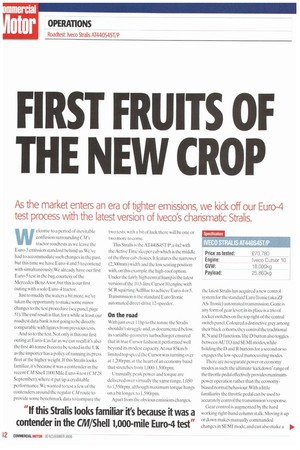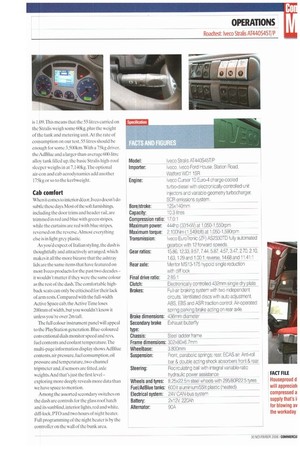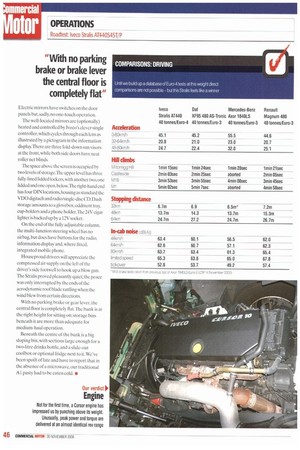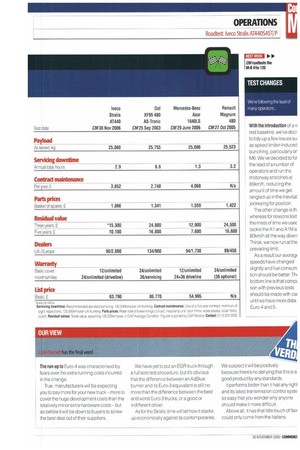FIRST FRUITS OF THE NEW CROP
Page 42

Page 44

Page 45

Page 46

Page 49

If you've noticed an error in this article please click here to report it so we can fix it.
As the market enters an era of tighter emissions, we kick off our Euro-4 test process with the latest version of Iveco's charismatic Stralis.
Welcome to a period of inevitable confusion surrounding CM!s tractor roadtests as we leave the Euro-3 emission standard behind us. We've had to accommodate such changes in the past, but this time we have Euro-4 and 5 to contend with simultaneously.We already have our first Euro-5 test in the bag. courtesy of the Mercedes-Benz Axor, but this is our first outing with a solo Euro-4 tractor.
Just to muddy the waters a bit more. we've taken the opportunity to make some minor changes to the test procedure (see panapage 51).The end result is that, for a while at least,our roadtest data bank is not going to be directly comparable with figures from previous tests.
And so to the test. Not only is this our first outing at Euro-4:as far as we can recall its also the first 40-tonne Iveco to be tested in the UK as the importer has a policy of running its press fleet at the higher weight. If this Stralis looks familiar, ifs because it was a contender in the recent CM/Shell 1000 Mile Euro-4 test (CM 28 September). where it put up a creditable performance. We wanted to test a few of the contenders around the regular CM route to provide some benchmark data to compare the two tests: with a bit of luck there will be one or two more to come.
This Stralis is the AT440S45T/P:a 4x2 with the Active Time sleeper cab which is the middle of the three cab choices. It features the narrower (2,300mm) width and the low seating position with, on this example,the high-roof option. Under the fairly high central hump is the latest version of the 10.3-litre Cursor 10 engine with SCR squirtingAdBlue to achieve Euro-4 or 5. Transmission is the standard EuroTronic automated direct-drive 12-speeder.
On the road
withjusi r LI hp to the tonne the Stralis shouldn't .truggle and.as documented below. its variable-geometry turbocharger ensured that in true Cursor fashion it performed well beyond its modest capacity.At our 85km/h limited top speed the Cursor was turning over at 1.20Orpm. at the heart of an economy band that stretches from 1.000-1.50Orpm.
Unusually, peak power and torque are delivered over virtually the same range,1,050 to 1,55Orpm. although maximum torque hangs on a hit longer, to 1,590rpm.
Apart from the obvious emissions changes, the latest Stralis has acquired a new control system for the standard EuroTronic (aka ZF AS-Tronic) automated transmission.Gone is any form of gear lever: in its place is a trio of rocker switches on the top right of the central switch panel.Coloured a distinctive grey among their black cohorts.they control the traditional R,N and D functions:lhe13 button also toggles between AUTO and SEMI modes, while holding the D and R buttons for a second or so engages the low-speed manoeuvring modes.
There are no separate power or economy modes as such: the ultimate 'kickdown range of the throttle pedal effectively provides maximumpower operation rather than the economybiased normal behaviour. With a little familiarity the throttle pedal can be used to accurately control the transmission's response.
Gear control is augmented by the hard working right-hand column stalk. Moving it up or down makes manually commanded changes in SEMI mode. and can also make a 110.
temporary shift in AUTO. Pulling the lever back once engages the engine brake at 100%; pull it again to force a downshift and increase its power. Buttons on the end and top of the stalk control the cruise control,which brings in the engine brake when over-running at 3km/h above set speed.
The parkbrake lever is conveniently mounted on the dash. lveco has yet to join the growing band of manufacturers offering hill-hold systems, but the Stralis is one of those admirable trucks with the intelligence to know that if you touch the brakes when you're over-running cruise speed, you probably don't want to disengage cruise control.
The electronic brakes worked fine apart from a minor glitch which served to demonstrate the Stralis's self-diagnosis capability. On the homeward stretch we notice a juddering from the front brakes once speed had dropped to near walking pace.The dash info display produced a fault code which was quickly translated to a front ABS fault (due, it turned out, to a dislodged wheel sensor which was confusing the system). It also accurately highlighted a blown offside front sidelight bulb.
As a driver's truck.the Stralis is exemplary Handling is sharp and the ride is on the firm side while never losing its composure on bumpy bits.
Productivity
It would be interesting to compare the Euro-4 Stralis with an identical truck at Euro-3 to see exactly how the new emission standard affects economy and performance:The different speeds on some parts of the test don't help here. Unfortunately, as mentioned, lveco normally specs test vehicles at maximum weight, but holding the figures up against those of a 6x2 AT 430 we tested in 2004 is enlightening.
With the loss of around three tonnes of potential payload, the F.uro-4AT440 40-tonner romped to 80km/11 in 45.1 seconds— an impressive 14 seconds faster than the 430, with proportionate savings on the in-gear times.Translated onto the road, all of our timed hillclimbs were completed about 20 seconds faster. On this showing, fears that Euro-4 will be a disaster for economy seem unfounded.The Stralis returned 8.77mpg, a full LOOmpg better than the Euro-3 Stralis at 44 tonnes,but 0.20rnpg behind the only other post-Euro-3 tractor tested, the Euro-5 Axor, which managed 8.97mpg. Of course, with SCR the cost of AdBlue has to be included The Stralis used it in a proportion of 4.2% to diesel. which was slightly higher than expected.The combined diesel/AdBlue cost per l(X)km is £28.34, compared with the previous 40-tonne Euro-3 430 Stralis's £29.12.
Looking at the other comparison vehicles in our chart.even with AdBlue the total cost is still no more than the higher end of the Euro-3 scale.
We should point out that the first part of the test was marked by a very strong headwind all the way to the Lake District and beyond. We decided to re-run this section on a calmer day:a decision justified by a saving of just over 10 litres from Hinckley to the services at Burton-inKendal.
Here's a fact you'll need to know: the average specific gravity of AdBlue is 1.09.This means that the 55 litres carried on the Stralis weigh some 60kg, plus the weight of the tank and metering unit. At the rate of consumption on our test. 55 litres should be enough for some 3.501km. With a 75kg driver. the AtiBlue and a larger-than-average 600-litre alloy tank filled up, the basic Stralis high-roof sleeper weighs in at 7.1401(g:111e optional air-con and cab aerodynamics add another 175kg or so to the kerbvveight.
Cab comfort
When it comes to interior dt:tcor,Iveco doesn't do subtle these days, Most of the soft furnishings, including the door trims and header rail, are trimmed in red and blue with green stripes. while the curtains are red with blue stripes, reversed on the reverse.Almost everything else is in light grey plastic.
As you'd expect of Italian styling, the dash is thoughtfully and attractively arranged. which makes it all the more bizarre that the ashtray lids are the same items that have featured on most Iveco products for the past two decades it wouldn't matter if they were the same colour as the rest of the dash.The comfortable high backseats can only be criticised for their lack of arm rests. Compared with the full-width Active Space cab. the Active Time loses 200mm of width, but you wouldn't know it unless you're over 2m tall.
The full colour instrument panel will appeal to the PlayStation generation. Blue-coloured conventional dials monitor speed and revs, fuel contents and coolant temperature.The multi-page information display shows AdBlue contents, air pressure. fuel consumption, oil pressure and temperature, two-channel tripmeter and, if sensors are litted.axle weights.And that's just the first level exploring more deeply reveals more data than we have space to mention.
Among the assorted secondary switches on the dash are controls for the glass roof hatch and its sunblind. interior lights, red and white. diff-lock.PTO and two hours of night heater. Full programming of the night heater is by the controller on the wall of the bunk area.
Electric mirrors have switches on the door panels but, sadly, no one-touch operation.
The well-located mirrors are (optionally) heated and controlled by Iveco's clever single controller, which cycles through each lens as illustrated by a pictogram in the information display There are three fold-down sun visors at the front,while both side doors have neat roller net blinds.
The space above the screen is occupied by two levels of storage.The upper level has three fully-lined lidded lockers, with another two, one lidded and one open. below.The right-hand end has four DIN locations, housing as standard the VDO digitach and radio/single-disc CD. Dash storage amounts to a glovebox.oddment tray, cup-holders and a phone holder.1 he 24V cigar lighter is backed up by a 12V socket.
On the end of the fully adjustable column, the multi-function steering wheel has no airbag, but does have buttons for the radio. information display and, where fitted, integrated mobile phone.
Houseproud drivers will appreciate the compressed air supply on the left of the driver's side footwell to hook up a blow gun. The Stralis proved pleasantly quiet; the peace was only interrupted by the ends of the aerodynamic roof blade rattling when the wind blew from certain directions.
With no parking brake or gear lever, the central floor is completely flat. The bunk is at the right height for sitting on; storage bins beneath it are more than adequate for medium-haul operation.
Beneath the centre of the bunk is a big sloping bin, with sections large enough for a two-litre drinks bottle, and a slide-out coolbox or optional fridge next to it. We've been spoilt of late and have to report that in the absence of a microwave, our traditional Al pasty had to be eaten cold. • TEST CHANGES
We're following the lead of many operators With the introduction of an test oaseline. we've decil to tidy up a few issues sui as speed limiter-induced bunching, particularly or M6. We've decided to fol the lead of a number of operators and run the motorway stretches at 85km/h, reducing the amount of time we get tangled up in the inevitat jockeying for position.
The other change is th whereas for reasons lost the mists of time we usec tackle the A1 and AIM a' 80km/h all the way down Thirsk, we now run at the prevailing limit.
As a result our averag( speeds have changed slightly and fuel corsum tion should be better. Thi bottom line is that comp( son with previous tests should be made with cal until we have more data Euro-4 and 5.
OUR VIEW
The run-up to Euro-4 was characterised by fears over the extra running costs incurred in the change.
True, manufacturers will be expecting you to pay more for your new truck more to cover the huge development costs than the relatively minor extra hardware costsbut as before it will be down to buyers to screw the best deal out of their suppliers. We have yet to put an EGR truck through a full solo test procedure, but it's obvious that the difference between an AdBlue burner and its Euro-3 equivalent is still no more than the difference between the best and worst Euro-3 trucks, or a good or indifferent driver.
As for the Stralis, time will tell how it stacks up economically against its contemporaries. We suspect it will be positively because there's no denying that this is a good product by any standards.
It performs better than it has any righl and its latest transmission control syste so easy that you wonder why anyone should make it more difficult.
Above all, it has that little touch of flair could only come from the Italians.


















































































































































































